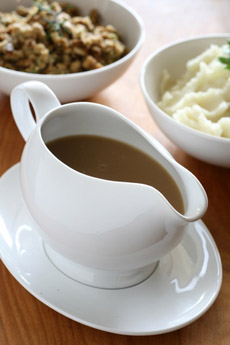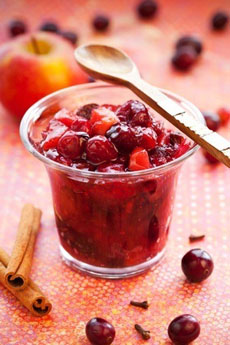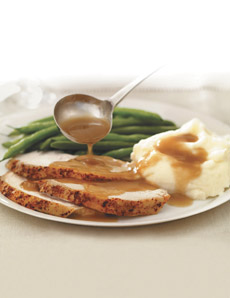|
If you need a delicious gravy recipe, here’s one from THE NIBBLE’s consulting chef, Eric Dantis. It will add mushroomy goodness to the turkey and soak into the mashed potatoes and stuffing.
Ingredients
1 pound button mushrooms, cleaned and trimmed, stems removed and sliced about 1/8 of an inch thick
1 half onion, diced roughly
1 small carrot, diced roughly
½ stalk celery, diced roughly
1 clove of garlic, smashed
2 quarts low sodium chicken stock
3 sprigs of thyme
2 tablespoons of flour
2 bay leaves
¼ cup low-sodium soy sauce
1 pint heavy cream
Wondra flour
Cooking oil: canola, olive or vegetable
Salt and pepper to taste
|
|

Mushroom gravy adds richness to the turkey,
stuffing and mashed potatoes. Photo by
J. Java | Fotolia. |
|
*Wondra is a brand of “instant flour,” a pre-gelatinized wheat flour mixed with some malted barley flour. It was formulated to dissolve quickly in hot or cold liquids, and is most popularly used to thicken gravies and sauces while avoiding lumps. If you can’t find instant flour you can substitute all-purpose flour. Use an immersion blender to blend out the lumps.
Preparation
1. Coat the bottom of a pot with oil and heat on medium-high.
2. When oil is hot, add carrots, celery, onion, garlic, mushroom stems, and about ¼ of the sliced mushrooms.
3. Season lightly with pinch of salt and pepper.
4. Sweat with no color for 10-15 minutes, until tender.
5. Add thyme, bay leaf; sprinkle in flour.
6. Cook for 5 minutes to toast the flour and cook out the raw flour flavor.
7. Add soy sauce and simmer for 5 minutes.
8. Add chicken stock, stir and increase heat to high.
9. Bring liquid to boil then reduce the heat to maintain a simmer.
10. Simmer for 30-40 minutes; skim off and discard any scum or residual grease.
11. While the stock is simmering, brown the reserved mushrooms in a separate pot with some oil.
12. After 40 minutes, strain the mushroom stock into the pot with the reserved browned mushrooms. Bring to boil over high heat; then reduce, maintaining a simmer.
13. Reduce the broth by at least half, or until the flavor of the salt level is to your liking.
14. Add half of the cream and bring back to a boil. The gravy should nap the back of a spoon. Taste and adjust the salt and pepper.
15. If the viscosity of the sauce is still too thin, sprinkle in Wondra a little at a time, whisking to avoid clumps. You need to bring the gravy to a boil in order to activate the gluten in the Wondra.
16. Strain one more time into a bowl and keep warm until ready to use.
17. If making a day ahead of time, do not add cream until reheating.
Let us know how you like it!
|






